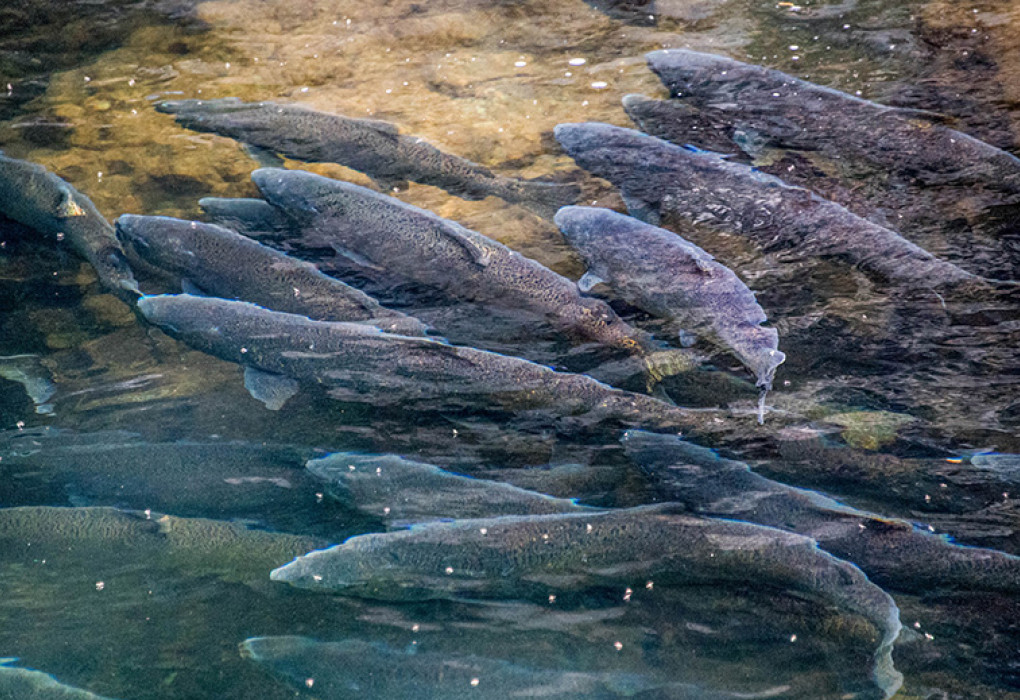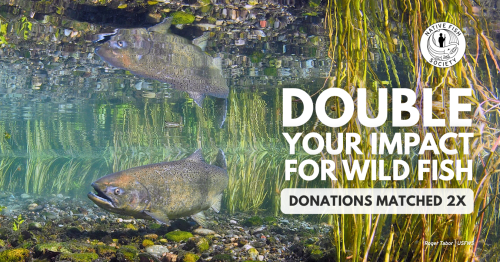Salmon Symphony
WORDS: Dana Sheedy, Native Fish Fellow
In 1995, I was an impressionable young fisheries biologist fresh out of graduate school making my way through the Columbia River Basin. That year, a Congresswoman from Idaho said that she “cannot take the endangered species listing of sockeye salmon seriously when I can buy a can of salmon off the shelf in (the store).” Made the same year that only eight sockeye salmon returned to Redfish Lake, Idaho, this comment forever echoes in the engagement of the pro-fish and environmental communities nationwide. Regardless of the juicy quotes that would haunt Helen Chenoweth’s political career, her comment reflects a widespread misunderstanding about the Endangered Species Act.
The ESA allows the federal government to list Distinct Population Segments. Although it has protected many species, this language comes with a bit of baggage. First, there is no agreed definition of a DPS, nor is this term used in population ecology. So we can only infer what was meant at the time the legislation was enacted. The definition of distinct is, simply: ‘Not the same.’ The definition of segment is: ‘A part of.’ So: parts of populations that are distinct in some recognizable way are eligible for protection under the ESA.
In order to define this DPS designation, the National Marine Fisheries Service utilized the concept of an Evolutionary Significant Unit and created geographic boundaries to protect and manage population status and trend. Conservation units, such as ESUs and DPSs, are a concept at the core of conservation biology, but the ESUs designated for salmon and steelhead are broad. For example, the entire Columbia Basin is divided into just five ESUs. Biologists often debate the “Goldilocks effect” (too big, too small, or just right) in the size of these units.
Fast forward 22 years. The ESA is the same, but the science related to the language that dictates policy decisions has changed substantially. Research conducted at the University of California, Davis turned the beliefs regarding the evolution of salmon upside down. This research identified a gene associated with two distinct runs in Chinook salmon and steelhead—an early premature (spring/summer run), and a later mature (fall/winter run), adult migrant. This research argues that these run types did not emerge independently in all basins across the range as formerly believed, but occurred in a single mutation event that spread.1 This hypothesis suggests that if an expression like the premature run is lost, it is unlikely to re-evolve. This research put the spotlight on the current DPS designations.
In some places, NMFS has recognized spring and fall run-timing in Chinook as distinct attributes for listing. For example, the Snake River spring/summer run and the fall run are listed separately. These runs use distinctly different habitats for spawning and early rearing, outmigration behavior, and timing of adult return migration. Chinook in the Oregon Coast and Klamath River DPSs, however, are not listed. In those areas, strong fall runs overshadow spring-run populations, but there is a lack of data on the separateness and abundance of these runs.
In several basins, such as Washington’s Walla Walla Basin and Idaho’s Clearwater Basin, the spring run was extirpated early in the twentieth century. A hundred years later, these runs are maintained by hatchery intervention, showing that the expression of the life history was not able to independently re-evolve. NMFS’s own expert estimates that, under the original hypothesis of numerous, within-basin evolutionary events, it would take a century to replace the lost premature migration life history.2 However, one hundred years without expression of a distinct population attribute is extirpation.
In 2004, researchers from the University of Idaho, University of Washington, and the Columbia River Inter-Tribal Fish Commission published a competing hypothesis. This hypothesis argued that Chinook were a continuum of run-timing and habitat utilization, which had been truncated by the progression and effects of European settlement.3 Under this hypothesis, Chinook and steelhead runs were segregated by temperature regimes at natal habitats. During the nineties, fisheries scientists were discussing the value of meta-populations—the idea that subpopulations, or segments, within a larger population support one another demographically. In reality, the lines are blurred from run to run and from population to population. Yet the precise homing common in salmon and trout populations speeds the process of local adaptation, so each subpopulation rapidly becomes suited to a specific location in order to maximize survival.
Fitting policy into reality is like putting a round peg into a square hole, so interpreting lab and theoretical science into effective action can be tricky. How do we draw lines around what should be single notes and instruments that play the symphony of an entire orchestra? Today, agencies are focusing on measuring the one gene associated with maturation at run-timing to address listing designations. However, getting hung-up on one gene is like looking for the needle in the haystack, when successful conservation and recovery revolves around maintaining all of the phenotypic diversity.
Salmon need cold, clean water, spawning gravel, suitable prey to match their energetic demands, and natural cycles to find a mate and reproduce. The policies implemented for salmon and steelhead across the native range have been insufficient to restore our runs. Overlooking biological constraints—run timing, associated habitat, and temperature regimes—are the root of the failure.3 DPSs should be assembled according to metapopulations, rather than ESUs.3 This would triple the number of designations. Revising salmon policy is critical to reversing declines and ensuring strong runs in the future.
1 Prince et al. (2017) Science Advances 3:e1603198
2 Waples and Lindley (2018) Evolutionary Applications 11:1518-1526
3 Brannon et al. (2004) Reviews in Fisheries Science 12:99-232
Alongside our partners at the Center for Biological Diversity and Umpqua Watersheds, we submitted a petition to list Oregon Coast spring Chinook salmon as a threatened or endangered species under the federal Endangered Species Act. Learn more about the NFS Protect Oregon Coast Springers Campaign at nativefishsociety.org/campaigns.


